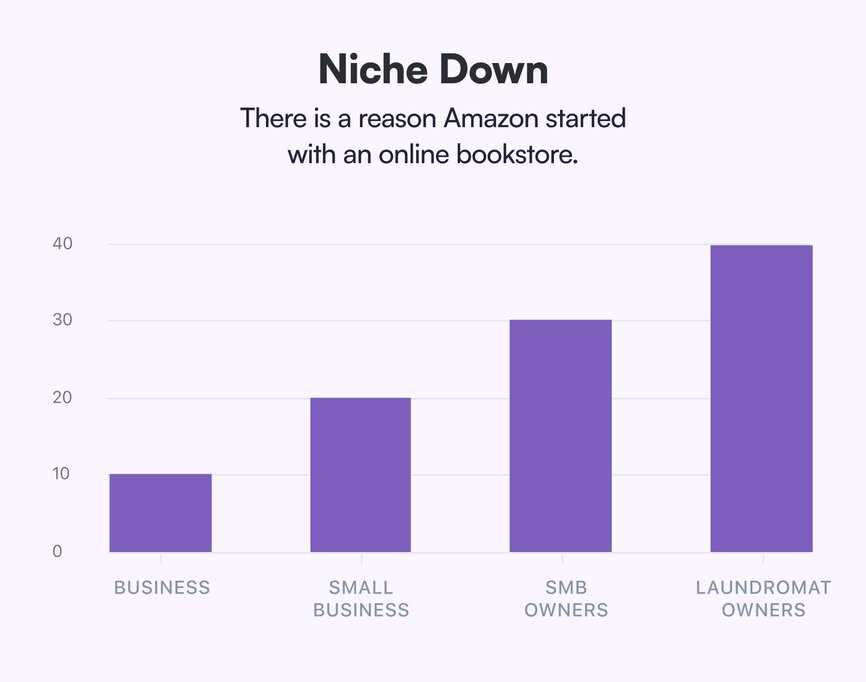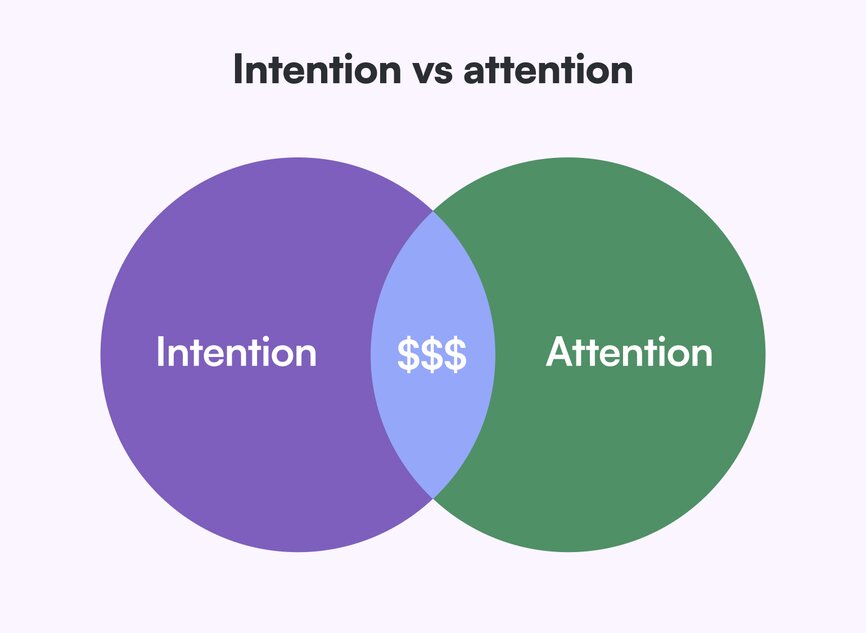The 8-figure entrepreneur's guide to finding your niche
What’s the secret to building an 8-figure education business that has a profit margin of 70-85%—but spends $0 on ads?
We sat down with serial entrepreneur and CEO of Contrarian Thinking, Codie Sanchez, to find out the exact steps she used to pick a niche and find success with her community.
When Codie quit her job and decided to go all in, she didn’t have a “great idea for a startup” like she wished for.
Instead, she niched. Into laundromats.
What is a niche? A niche is a specialized segment of the market for a particular kind of product or service.
Codie is a reformed journalist, Wall Streeter and investor who built a $50 million portfolio of “boring businesses”—like laundromats, vending machines, and car washes. Now, she helps people learn to build wealth through unconventional business buying strategies, just like she did.
Bottom line: Being an expert on one niche thing is much more valuable than knowing a little about a lot. And it’s the only way to build a valuable community and a thriving business.
“There’s a reason a hedge fund manager, Jeff Bezos, started Amazon as an online bookstore,” says Codie.
So, even if you haven’t found your niche yet, it doesn’t mean you can’t find an area of expertise to seed your business.
In this article we’re going to uncover some key concepts from Codie’s playbook on how to find your niche.
The goal
The goal of niching down is choosing some small subsection of a topic you know everything about—that can grow to become a profitable business for you.
Codie’s example
Codie’s goal was two-fold: in life, she wanted to become her own kind of billionaire (as in, yachts didn’t impress her, but freedom and leaving a legacy did.) For her community, she wanted to figure out how to help the most people humanly possible buy small businesses—because in her eyes, this was the key to financial freedom.
But for years, she just made lots of money for others. She knew slogging away for someone else wasn’t going to get her to billionaire status, but couldn’t figure out what kind of business to start for herself.
Until she decided to apply what she excelled at at work—brokering deals, managing mergers and acquisitions, and buying businesses—on a smaller scale to herself.
TLDR: She used an area of her unique expertise to build a business only she could build.
The plan
In order to find a profitable niche, first, you have to be honest with yourself about your expertise and knowledge. Then, you have to be honest with others.
Find your unique and valuable qualities—and a business that will make you money—using
Codie’s 3 C’s:
- Cash: Are people spending money on this thing I’m interested in building a business around?
Example: Resume-writing services are usually geared towards people who don’t have a job, so it automatically becomes a low-priced skill. Alternatively, the market for people who are having children is massive, and people are spending tons of money on it. - Crowd: Are there people who need this? Does your skill, talent, or knowledge solve a problem for them?
Example: If you like gardening, candle-making, or, in Codie’s case, owning laundromats—an easy way to validate how big demand for those things is through Facebook groups. Big communities with lots of engagement? Bingo. - Curiosity (yours, not the market’s): Are you obsessed and engaged with your topic?
“It’s astounding how easy it is to get others onboard if you’re excited and obsessed with your topic,” says Codie. Plus, you’re going to be talking to other humans about your topic a lot if you’re successful.
Remember, your niche doesn’t have to be a big and flashy thing. You don’t have to be the next Dave Ramsey out of the gate. It can be small and “boring.” In fact, when you’re exploring starting a business: small, boring, and targeted is perfect.
“What could be more boring and uninteresting than laundromats?” asks Codie. “But if I can talk about laundromats, you can, too.”
The playbook
While still working full-time, Codie began buying and investing in small, local businesses like laundromats, vending machines, and car washes.

When she decided to teach others to do the same thing—she had to niche down to those who’d benefit from that specific knowledge.
Instead of trying to share all she’d learned about money as an investor, a business owner, or a mergers and acquisitions specialist, she literally created a course about buying local laundromats for aspiring small to medium business (SMB) buyers.
She went from wide (teaching about money) to narrow (teaching SMB buyers how to buy laundromats) by going 4 levels down.
Go 4 levels down
- Start with what you know, and who your knowledge serves on a wide scale
- Then, get more specific 3x until you hit a market and a population whose problems you’re intimately familiar with and can solve clearly
- Check the example below ⬇️

Other examples of niching:
- Real estate > Commercial real estate > Gyms and studios > Gyms and studios in [City]
- Health and wellness > Health and wellness education > Nutrition education > Nutrition coaching
That first course about buying laundromats? It earned Codie ~$150k when she first launched it, and provided the proof of concept she needed to launch her community.
Find Waldo
Codie reminds us: “The #1 rule in finance and investing is: if you say, ‘we’re for everyone’, that actually means you’re for no one.”
In the land of courses and communities, you’re competing with a lot of noise. It’s busy here, and people are marketed to from every side, no matter what your topic or industry.
That’s why you have to ask: Where’s Waldo?
“You want to narrow in as close as possible to your unique little weirdo [your customer] who’s red and white and striped in some way,” says Codie.
Reminding yourself that your target customer is specific, small, and select helps you ignore the noise of the rest of the market.
As Kevin Kelly, founding executive editor of Wired magazine, says, “To make a living as a [creator or entrepreneur]... you need only 1,000 true fans.”
According to Codie, you can use your 1,000 true fans to “never be poor”—if you find the intersection of attention and intention.

The truth is: There are new creators out there going viral every day—but they don’t do anything with the attention they receive and lose their chance to funnel folks towards their business.
They waste their opportunity.
But, when you combine targeted attention from a niche group of people (Waldo) who have similar problems, with the intention of solving those problems with your unique expertise…
You get massive community support and buy-in, a built-in focus group for new and better products, and $$$.
Codie found success in her education and community because she solved the problems of a niche market (SMB buyers) better than anyone else. She didn’t just gather people for no reason: she funneled them towards her content and the solutions that solved their problems.
That community became her “always-on focus group” to develop more products—and created a live problem 🔄 product feedback loop that kept her content relevant, valuable, and in-demand.
It’s how her business ballooned from an initial course that brought in $150,000, to an 8-figure (that’s double-digit millions) business in under 2 years.
The results
“I’ve been an investor, done 100+ deals, owned 22 companies, and done billion dollar deals.”
Codie knew about Money—but Money (capital M) was too broad for her to make a dent in it from the get-go. All 330 million people in the US care about money.
She had to narrow down to the 2-3 million people who have ever bought or are considering buying a business.
And for that niche, she built an 8-figure education business that…
- Spends 0$ on ads
- Has 70-85% profit margin
- Sends 600,000 emails with a 50% open rate
Not only that, but she now charges $10,000 to join her SMB buyer community (a serious investment compared to the $99 lifetime access membership she offered initially.)
Codie may not have set out to be an educator about laundromats… But she did plan to succeed.
TLDR: Codie wouldn’t have found that success (in less than two years!) if she hadn’t first found a niche whose problems she could confidently solve.

Codie’s learnings:
- In the beginning, Codie created lots of free content because she still had her full-time job (and the luxury of cash). Once she proved her concept with her first laundromat course, she added a community.
- If she had to do this again, she’d start and monetize a community first. Why? Because you can charge the most for a community, and you start building your 1,000 true fans—or as Codie says, her R&D team. (You can see that now, she has a small business buying course worth $2,000, while her community costs $10,000 to join.)
- The power of the problem 🔄product loop is endless. Because:
- Once you have your niche community, they share their problems and questions with you, which you turn into a product roadmap. (Struggling with finding a lawyer? Here’s a marketplace. Can’t assess your business deal? Here’s an expert.)
- That turns into better products, which her community is happy to pay for (and makes her more money)
- Happy customers then turn into fantastic marketing content, and so the loop continues.
- This virtuous circle that only happens in communities. It’s the 21st century way to build businesses and products.
- “Your first fans are going to spend the most with you. So charge the most at the start, bring them into the community, and do things that don’t scale to start. Then you can scale in the backend.” - Codie
Key takeaways
- Trust building is key. You need to align your true expertise with the problems and needs of a niche market. “Don’t fake it till you make it, even if you’re the only one who’s going to know if you’re full of sh*t or not,” says Codie, because you’ll be building on a false foundation.
- Your audience won’t tell you the right thing to build. Your expertise will. Your audience will simply tell you their problems over, and over, and over—without knowing what will solve that problem (yes, even if you ask them directly). That’s where you come in, and why you can charge them for the solution.
- Niching helps you build an avid community of true fans, which then helps you build better products. The narrower you start, the quicker your reputation grows as a great investment (because you’re really solving people’s issues), and the quicker you can iterate and expand.
- Start smaller than you think. Don’t go after the big boys to prove yourself—but also don’t hesitate to have big dreams as you start to find success. Prove your concept with your audience, and solve bigger problems as you grow.
And if you’re looking for an all-in-one community platform for your 1,000 true fans?
You’re in the right place.
Circle brings together your members, discussions, events, courses, and content—all in one place, under your own brand. Plus, you get access to our customer community full of handy resources and over 8,500 community builders on the same journey as you.
Start your free 14-day free trial today!